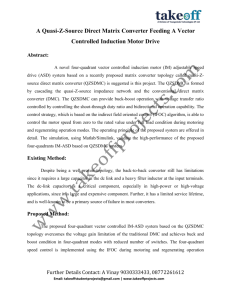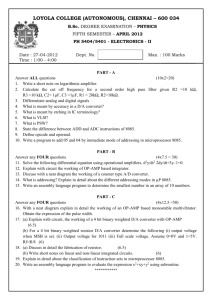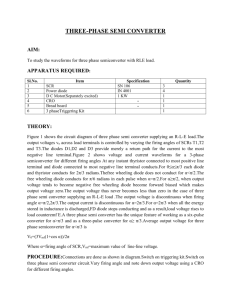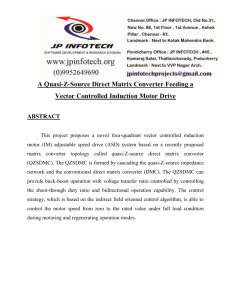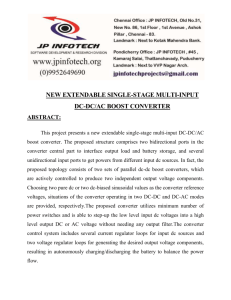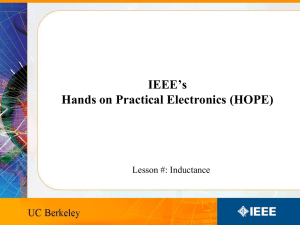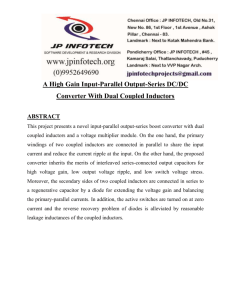ch20sec11
advertisement
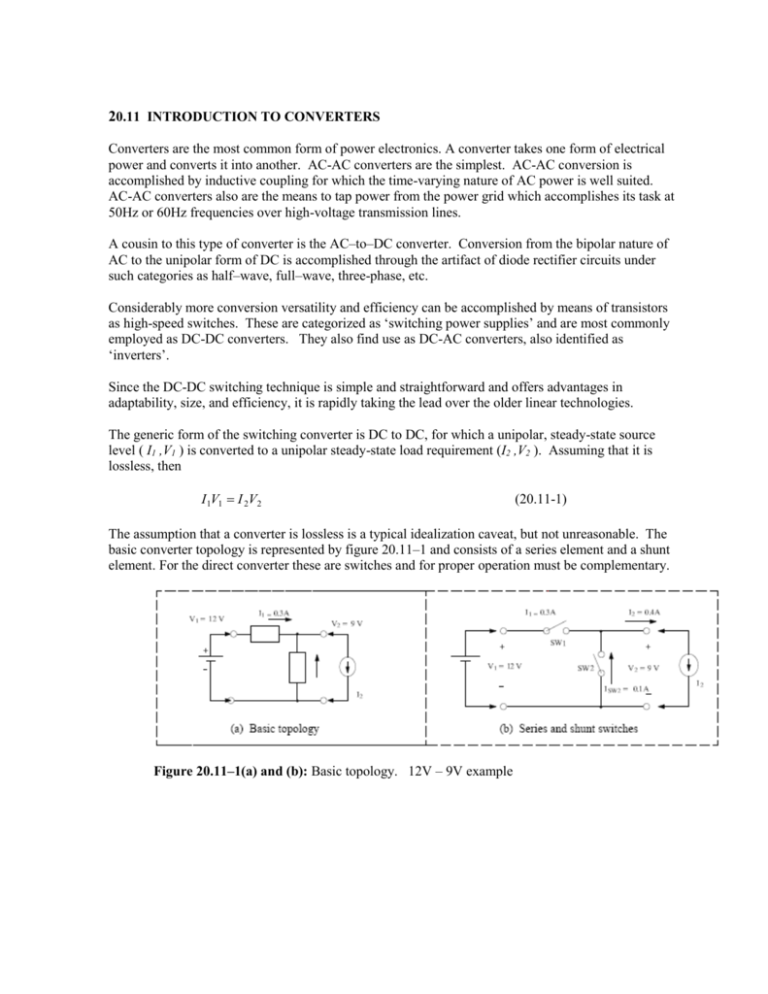
20.11 INTRODUCTION TO CONVERTERS Converters are the most common form of power electronics. A converter takes one form of electrical power and converts it into another. AC-AC converters are the simplest. AC-AC conversion is accomplished by inductive coupling for which the time-varying nature of AC power is well suited. AC-AC converters also are the means to tap power from the power grid which accomplishes its task at 50Hz or 60Hz frequencies over high-voltage transmission lines. A cousin to this type of converter is the AC–to–DC converter. Conversion from the bipolar nature of AC to the unipolar form of DC is accomplished through the artifact of diode rectifier circuits under such categories as half–wave, full–wave, three-phase, etc. Considerably more conversion versatility and efficiency can be accomplished by means of transistors as high-speed switches. These are categorized as ‘switching power supplies’ and are most commonly employed as DC-DC converters. They also find use as DC-AC converters, also identified as ‘inverters’. Since the DC-DC switching technique is simple and straightforward and offers advantages in adaptability, size, and efficiency, it is rapidly taking the lead over the older linear technologies. The generic form of the switching converter is DC to DC, for which a unipolar, steady-state source level ( I1 ,V1 ) is converted to a unipolar steady-state load requirement (I2 ,V2 ). Assuming that it is lossless, then I 1V1 I 2V2 (20.11-1) The assumption that a converter is lossless is a typical idealization caveat, but not unreasonable. The basic converter topology is represented by figure 20.11–1 and consists of a series element and a shunt element. For the direct converter these are switches and for proper operation must be complementary. Figure 20.11–1(a) and (b): Basic topology. 12V – 9V example Figure 20.11–1(c): (I,V) waveforms for the 12V – 9V converter The switching power supply relies on time-averages levels as defined by the duty cycles of its two switches. The duty cycle D of SW1 defines the average voltage level V2 that is transferred from the source side to the load side. Switch SW2 keeps the current I2 flowing through the load when switch 1 is off. For the converter represented by figure 20.11–1, switch #1 has a duty cycle D = 0.75 and switch #2 will therefore have complementary duty cycle (1 – D) = 0.25. V1 is assumed to be a steady levels of voltage. I2 is assumed to be a continued flow of current, as afforded by SW2. The action of the switches and time-averaging then yields V2 V2 (t ) DV1 (20.11-2a) I 1 I SW1 (t ) DI 2 (20.11-2b) where x(t ) indicates time averaging. The variation in levels from the switching action are smoothed over by use of capacitances and inductances. Note that equations (20.11-2a) and (20.11-2b) also obey the lossless condition (equation (20.11-1)). The switching is usually executed at sufficiently high frequencies so capacitance and inductances of modest sizes can be used to smooth out the waveforms. Both of these elements are energy storage elements, for which capacitances are used to store voltage (in the form Q/C), and smooth out the voltage waveform and inductances are used to store current and smooth out the current waveform. The effects of these components in the circuit are realized by the definitions dV I dt C (20.11-3a) dI V dt L (20.11-3b) for which the larger the values of C and L, the smaller the ripple. Equation (20.11-3b) is also emphasizes that an emf (voltage) will be generated across the inductance with a change in current. This effect is manifested by figure 20.11–2 for which an interruption of current flow such as that caused by a switch induces an emf of magnitude that can easily break-over the switch gap. In the early part of the century, when many unwary experimenters would hook up a DC induction motor to a simple knife switch, a panicky yank on the switch to shut off the motor would create an enormous, dangerous arc, usually sufficient to melt parts of the switch. In modern circuits, this effect merely annihilates the switching transistor as the overvoltage surges well beyond junction breakdown. For this reason, many circuits containing an inductance add a ”snubber” to shunt destructive overvoltage spikes and arcs. Snubbers are even included in digital integrated circuits, since at high switching speeds, the small inductances due to long interconnects may be sufficient to cause large overvoltages. Figure 20.11–2: Induced voltages in an inductance due to current interruption. This effect is of advantage in converter circuits because the opening of the controlled switch will induce sufficient reactive voltage to turn on a reactive switch such as a didoe. This action is illustrated by figure 20.11–3. Figure 20.11–3: Inductive complementary switching by means of a diode. As indicated by the figure the diode is pulled into forward bias by the emf induced across the inductance. The diode will therefore serve as the complementary switch to that of the controlled switch (which usually is a transistor) A complete converter circuit might then be represented by figure 20.11–4, which represents the topology which we usually call a direct converter. Figure 20.11–4: The direct converter topology (down converter). T direct converter topology relies on the switches. For this topology the input voltage is stored on capacitance C so that the voltage V1 supplied to the switches is = VC. The capacitance is discharged by current I2 flowing out of it during the interval in which SW1 is on and is supplied continuously by current I1 flowing from the input source as represented by figure 20.11–5. Figure 20.11–5: Discharge current The drop in voltage on the capacitance over the interval from 0 to DT is then 1 VC V1 C DT I 2 0 I 1 dt 1 I 2 I 1 DT 1 1 I 1 DI 2 T C C I2 which is the same as VC V1 I1 1 DT C (20.11-4) since D x I2 = I1. Equation (20.11–4) represents the decrement of VC during discharge or the magnitude of the ripple. Figure 20.11–5 illustrates the effect of the capacitance on average voltage V1. Figure 20.11–6. Ripple on V1 = VC . The amplitude of this ripple can also be evaluated by evaluating VC when SW1 is open for which the capacitance is charged up by a flow of current I1 onto the capacitance. This current causes an increment of voltage across C of value VC V1 1 C T I1 I dt C 1 D T 1 (20.11–5) DT and is the same as that of equation (20.11–4). Which is expected, should be no surprise. Similarly, a ripple in the current I2 will occur as the inductance discharges through the load while SW2 is closed, i.e. T I 2 V 1 V2 dt 2 1 D T L DT L (20.11–6a) This ripple will induce a corresponding ripple in V2, i.e. V2 I 2 R2 (20.11–6b) ********************************************************************************** EXAMPLE 20.11–1: The circuit of figure 20.11–7 shows a direct converter which is supplied by a source of value VB = 26 V and internal resistance RB = 0.1. RB also acts as the resistive component of the R-C input filter. It is assumed that the load can be represented by R2 = 0.1.. It is switched by a clock at fs =50 kHz. (a) What are the converter values I2, V1, and I1 and what duty cycle D is required. (b) What values of L and C are needed to keep the current ripple at the output and the voltage ripple of the input to less than 2%? Figure 20.11–7: 26V–to–5V direct converter operating at fs = 50 kHz SOLUTION: For V2 = 5V, we have: I2 = V2/R2 = 5/0.1 = 50 A. Assuming V1 x I1 = V2 x I2 = 250 W, and I1 = ( 26 – V1 )/R1, we get the quadratic: 10V1(26 - V1) = 250 which has solutions V1 = 25 and V1 = 1. Only the solution V1 = 25V makes sense since the other solution is less than V2 (= 5V). For this value, we then get: I1 = (26 – V1 )/R1 = 10A The duty cycle D is then: D = V2 / V1 = 0.2 The ripple current at the output is, from equation (20.11–5), I 2 .02 50 1 5.0 (1 0.2) 20 s L from which the inductance needs to be (at least) L 5.0 0.8 20u 0.02 50 = 80H Similarly, from equation (20.11–4) V1 .02 25 1 10 (1 0.2) 20 s C from which the capacitance will need to be (at least) C 10 0.8 20u = 320F 0.02 25 ********************************************************************************** The topology of figure 20.11–4 requires the need of the quadratic equation V1 V B V1 PL R B which has solution V1 VB 2 1 1 4 PL R B V B2 (20.11–8) where only the positive root is valid, required in order that V1 > V2. The topology represented by figure 20.11–4 is also called the down converter or buck converter, since it ”bucks” the voltage down to a lower output level. It has a sister topology that uses the same principles, called the boost converter or up converter, represented by figure 20.11–8. Figure 20.11–8: The direct converter ‘boost’ topology. This converter topology takes the energy that is stored in the inductance during the first part of the duty cycle and dumps it into the right–hand side of the circuit. It does so the higher voltage induced across the inductance when the current through the transistor is switched off. Assume that D’ represents the duty cycle of the transistor. When it turns off the emf induced across the inductance rises until it is sufficient to turn the diode on. The interval fraction for which the transistor is off corresponds to duty cycle (1–D’). The conduction current through the diode is therefore I D I 2 (1 D ' ) I 1 (20.11–9) Since we require that the circuit be lossless, for which I2V2 = I1V1, then, by equation (20.11–9) the voltage at the output must be: V2 V1 (1 D ' ) (20.11–10) Since (1 – D’) is always less than 1, then V2 > V1, and the converter therefore ’boosts’ the voltage. The voltage across capacitance C is VC = V2. Compare this condition to the buck converter, it was V1 that fell across capacitance C. Therefore, if we designate D = the duty cycle of the series switch, which for the boost converter the diode and defined by (20.11-9) as 1 – D’, then equations (20.11–10) and (20.11–2a) are the same. This is no coincidence, of course. The topologies are exactly the same, except that figure 20.11–8 is a right–to–left reflection of figure 20.11–4. The only difference is in the arrangement of the controlled switch and the diode. Analysis is therefore entirely the same as for the down converter except that subscripts are interchanged. Ripple equations for voltage across the capacitance and current through the inductance are the same as (20.11–4) and (20.11–6), except that the subscripts may be interchanged if we adhere to subscript 1 as being at the input and subscript 2 as being at the output. A comparison is represented by example 20.11–2. ********************************************************************************** EXAMPLE 20.11–2: Warrior–brand combat underwear uses a muscle electrostimulation (ESM) unit which requires 72V at 1A to operate in the superman mode. If it is supplied by a 9V battery belt capable of supplying 50A of short–circuit current, determine (a) converter values V1, and I1 and duty cycle D’ of the controlled switch, (b) values of L and C needed to keep the voltage ripple at the output and the current ripple of the input to less than 2%, assuming that the circuit is toggled at switching frequency fs = 50 kHz. SOLUTION: (a) the output requirement is P2 = PL = I2 V2 = 1A x 72V = 72W. Assuming that the converter is approximately lossless, I1V1 = I2V2. In this case we have V1 = VB – I1R1, where VB = battery voltage = 9V and R1 = RB = 9V/50A = 0.18W. Therefore (V B I 1 R B ) I 1 P2 72 Which, with values is of the form (9 0.18 I 1 ) I 1 72 which has solutions I1 = 10A and 40A. Although both solutions will work, I1 = 10A is the more reasonable one, and will correspond to V1 = 7.2V and D’ = 1 – I2/I1 = 0.9 (b) For ripple of less than 2%, V2 = VC = .02 x 72 = 1.44 V According to equation (20.11-4) C I1 1 DT VC For the boost converter D’ and (1 - D) are analogous, since both are the fraction of the cycle for which the two sides are disconnected. I1 is the current flowing off the capacitance, which for the boost converter corresponds to that through the load = 1.0A, so that C 1.0 (0.9 20 s) 1.44 = 12.5F where we have used T = 1/fs = 20 Similarly for a 2% ripple in input current, and evaluating for the condition that SW1 = ON (and for which the two sides are disconnected) 1 I 1 I L .02 10 (7.2 (0.9 20 s)) L and which gives L = 648H ********************************************************************************** The topology of figure 20.11–8 requires the need of the quadratic equation (V B I 1 R B ) I 1 PL for which the required solutions is I1 1 1 4 PL R B V B2 VB 2 RB (20.11–11) Synopsis: For the direct converter (whether up or down), equations (20.11-8) and (20.11-11) are the benchmarks for the voltage and current transfer from one type of energy storage element to the other and can be restated as 1 1 4 PL R B V B2 VC VB 2 IL VB 2RB 1 1 4 PL R B V B2 (20.11–12a) (20.11–12b) for which VC is the averaged voltage that appears across the capacitance and IL is the averaged current that flows through the inductance. Equations (20.11-12a) and (20.11-12b) identify the unknown input level, from which the duty cycle D that is required to accomplish the conversion can then be identified. The ripple across these elements is defined by the R-C and R-L constants which can be restated in terms of equations (20.11-4) and (20.11-6a) IC Dseries (off )T C (20.11-13a) VL Dseries (off )T L (20.11–13b) VC I L where the usage identifies that the ripple is stated in terms of current IC that is supplying the capacitance and voltage VL that is supplying the inductance. The use of Dseries(off) nomenclature identifies the fraction of the duty cycle for which the two sides of the converter are electrically isolated from each other as results of the series switch being off. It is a little more practical to express equations (20.11-13a) and (20.11-13b) in terms of the time constants C = RC C and L= RL /L, where RC is the resistance in the capacitance path and RL is the resistance in the inductance path, whether these resistances be in the front end of the converter or the back end. Using the facts that VC = IC x RC and IL = VL /RL these equations take the form VC 1 t (off ) VC C (20.11-14a) I L 1 t (off ) IL L (20.11–14b) In the case of the direct-down topology, the resistance in the capacitance path corresponded to RB and the resistance in the inductance path corresponded to RL. And for the 1-2 nomenclature used with this topology, I1 corresponded to IC and I2 corresponded to IL. It is probably not good practice to assume that the resistance RB of the power source be equal to zero, but if it is assumed then the down-converter will have no need of a capacitance and (apparently) the up-converter will have no need of an inductance (which is not true). The mathematics does become simpler since the duty cycle D is sufficient to describe the relationships between input and output, since both are then either known or identified by the load requirement and the source characteristics.. Another topology is the indirect converter represented by figure 20.11–9. This topology can be either an ‘up‘ converter or a ‘down’ converter. Figure 20.11-9. The indirect (buck-boost) converter topology If we acknowledge that the time average of voltage over the inductance must be zero, then V1 DT V2 (1 D)T 0 so that V2 D V1 1 D (20.11-15) where D is the duty cycle of the controlled switch and T is the period of the cycle. Depending on the value of D, V2 can be either greater or less than V1. We also note that the average capacitance current must be zero, in which case, I 2 DT I 1 (1 D)T which is the same as I2 1 D I1 D (20.11-16) This result just confirms that the (ideal) net power going into the converter should be zero, assuming that the converter is approximately lossless. But as is true for the power amplifiers, the converter is not lossless, since some power is dissipated in the switching components themselves. For the cases represented by figure 20.11–4 and its cousins, these are the transistor(s) and the diode(s). Although considerably better than mechanical switches, these components will have finite turn–on and turn–off times during which significant power levels are dissipated in the switches. The principle is represented by figure 20.11–10. Figure 20.11–10: Power dissipation in the switches. Assuming that a switching transition can be represented by an approximately linear behavior over transition interval (0 < t < tON) as represented by Figure 20.11–8, then during this transition time I (t ) I ON i t ON and t V (t ) VOFF VON 1 t ON VON The power dissipated in the switch during transition is the time–average P(t ) over the switching interval 0 < t < tON for which P(t ) 1 T tON 0 I (t )V (t )dt t 1 1 VON I ON VOFF T 6 3 VOFF (20.11-17) where t is the transition time (= either tON or tOFF) and T = 1/fS, with fS = switching frequency. Equation (20.11-17 is the same for either the ON-OFF or the OFF-ON transition. The current ION that passes through either one of the switches is always the current through the inductance. The voltage VOFF across a switch is always the voltage across the capacitance. It should be no surprise that the energy–storage elements define the levels of voltage and current that are switched on/off by the two complementary switching elements to yield the desired I1,V1 -> I2, V2 conversion. Furthermore, the power dissipated when the switch is on is DT t ON PD (ON ) I ON VON T (20.11-18) where D is the duty cycle for the switch, whether defined by external control or defined by the reflexive nature of the circuit. Turn–on and turn–off times tON and tOFF are a function of the levels of current and voltage, since these switches must usually be ”charged up” for minority–carrier injection or the depletion of a drift region. tON and tOFF are on the order of s for large power transistors and diodes . These response times are the fundamental limit to the switching speed fs. Also the switches themselves will have a finite voltage drop, which, as we noted in section 20.3. These may on the order of 1 to 6V for a power BJT in the ”ON” state. A power diode will have an ”ON” voltage drop on the order of 0.6V to 2.0V. For low–voltage converters, as represented by examples 20.11–1, and 20.11–2, common off–the– shelf, large BJTs and diodes may be used, for which the voltage drop across the devices is less severe. ********************************************************************************** EXAMPLE 20.11–3: Assume that the controlled switch (= BJT) of example 20.11–1 has VCE (on) = 1.0V, and that the diode has V(on) = 0.6 V. Assume that tON = 1.0s = tOFF for both devices. Determine the power dissipated in the switches. SOLUTION: The switching frequency fS = 50kHz, for which 1/fS = 20s. From the example ION = IL = I2 = 50A and VOFF = VC = V1 = 25V. From equation (20.11–8) the power dissipated during switch transitions is then PD1 (transition) 50 25 1.0s 1.0s 1 1 1.0 20 s 6 3 25.0 = 22.5W PD 2 (transition) 50 25 1.0s 1.0s 1 1 0.6 20 s 6 3 25.0 = 21.8W The power dissipated during the time when the switches are ‘ON is (0.2 20 s) 1.0s 20 s (0.8 20 s) 1.0s PD 2 (ON ) 50 A 0.6V 20 s PD1 (ON ) 50 A 1.0V Therefore the power dissipated budget due loss in the switches is = 7.5W = 22.5W PD1 PD1 (trans ) PD1 (ON ) = 30W PD 2 PD 2 (trans ) PD 2 (ON ) = 44.3W This loss represents a total PD of 74.3 W. Since the power load requirement was 250W, it is necessary to factor this power loss into the analysis, for which it is apparent that duty cycle D will have to be increased in order to compensate for the loss in the switches. The process is iterative. If iterations are carried back and forth between examples 20.8.1 and 20.8.2, with the modification I 1V1 I 2V2 PD where PD = PD1 + PD2, we find that the duty cycle must be slightly increased, to D = 0.203. And with this change, we find also that V1 must be increased to= 24.62 V ********************************************************************************** In example 20.11–3, the change in the duty cycle D due to the power loss in the switches is relatively minor. The analysis does alert us that we need to have a BJT and a diode capable of dissipating approximately 30W and 44.3W, respectively. Allowing for safety margins and de-rating via the heat sinks, this converter can probably be constructed using a 75W power transistor and a 100W diode the load.

